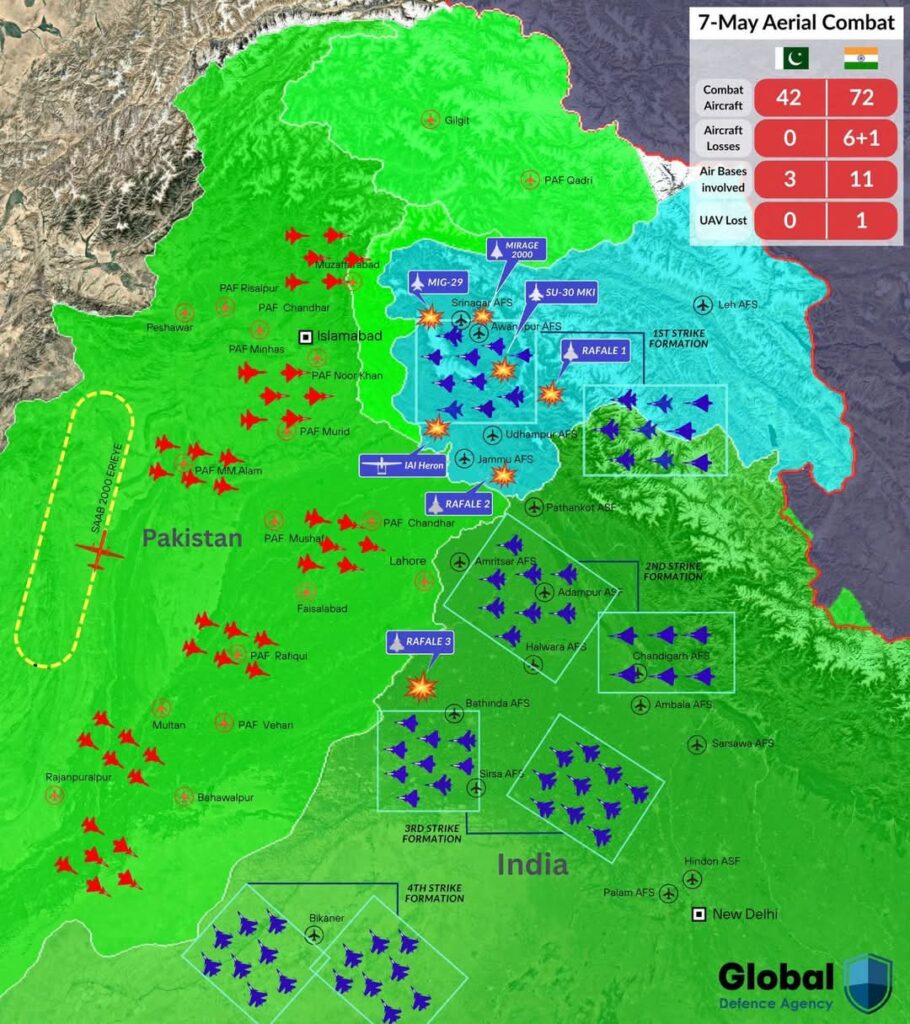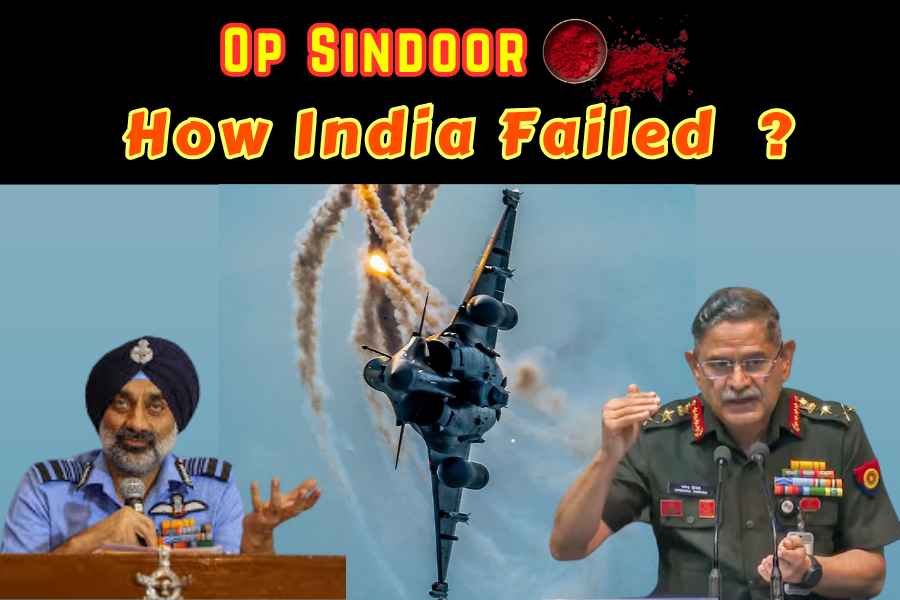(By Khalid Masood)
On 7 July 2025, during his address to the graduating officers of the National Security and War Course at the National Defence University (NDU), Islamabad, Field Marshal Syed Asim Munir, the Chief of Army Staff (COAS), delivered a clear and resolute message. He noted that India’s inability to achieve its stated military objectives during Operation Sindoor, followed by an attempt to rationalise this failure through convoluted logic, was a telling indictment of New Delhi’s lack of operational readiness and strategic foresight. He dismissed Indian insinuations about external support to Pakistan’s successful counteroffensive—Operation Bunyan-un-Marsoos—as not only irresponsible but factually baseless. These claims, he said, reflected a chronic refusal to acknowledge Pakistan’s indigenous capability and institutional resilience, painstakingly developed over decades of disciplined strategic evolution.
Launched in May 2025 in response to the 22 April Pahalgam attack, Operation Sindoor was India’s high-profile attempt to dismantle alleged terrorist infrastructure inside Pakistan and Azad Kashmir. Presented as a bold counterterrorism strike, the operation was intended to neutralise militant bases, disrupt their logistics, and reassert India’s regional dominance. Instead, it backfired. Operation Sindoor proved to be a strategic failure—exposing critical gaps in Indian military doctrine and achieving none of its stated aims. In contrast, Pakistan’s rapid and coordinated response through Operation Bunyan-un-Marsoos highlighted not only military effectiveness but also a strong sense of national resolve.
As Pakistan now enters a transformative phase of military modernisation—pursuing advanced platforms such as China’s J-20 and J-35 stealth fighters, KJ-500 AWACS, HQ-19B air defence systems, microwave-based drone neutralisers, Türkiye’s KAAN stealth jet and unmanned platforms, and Azerbaijan’s drone-jamming technologies—its deterrence posture is evolving decisively. This article examines the failure of India’s military gamble, the resurgence of Pakistan’s strategic confidence, and the shifting dynamics of power in South Asia.

I. Background: The Pahalgam Catalyst and India’s Misguided Ambitions
The 22 April 2025 Pahalgam attack in Baisaran Valley, Jammu and Kashmir, which killed 26 civilians, provided India with a pretext for Operation Sindoor. Indian Prime Minister Narendra Modi and External Affairs Minister S. Jaishankar accused Pakistan of sponsoring The Resistance Front (TRF), an alleged Lashkar-e-Taiba (LeT) affiliate, without verifiable evidence. India escalated tensions by suspending the Indus Waters Treaty, closing the Wagha-Attari border, and banning 16 Pakistani YouTube channels, aligning with the Doval Doctrine’s focus on pre-emptive strikes and narrative control. Pakistan condemned the Pahalgam attack, denied involvement, and called for an impartial international investigation, a stance supported by the UN Security Council’s 25 April resolution, which avoided naming Pakistan.
India’s military objectives were threefold: destroy LeT and Jaish-e-Mohammad (JeM) camps in Azad Kashmir and Punjab, disrupt their operational networks, and restore deterrence following the perceived failure of the 2019 Balakot air strikes. Indian media, including The Times of India, hyped Operation Sindoor as a “surgical strike” to project military superiority. However, these goals were unmet, as India underestimated Pakistan’s military readiness, misjudged its intelligence capabilities, and overreached diplomatically, leading to a catastrophic failure.
II. Execution of Operation Sindoor: A Flawed and Ineffective Campaign
On the night of 6–7 May 2025, the Indian Air Force (IAF) launched Operation Sindoor, deploying over 100 sorties with Rafale, Mirage 2000, and Su-30MKI jets, targeting alleged militant hideouts near Kotli, Muzaffarabad, and Bhimber in Azad Kashmir and Pakistan’s Punjab province. Indian Air Marshal Awadhesh Kumar Bharti claimed on 8 May that the strikes were “precise,” targeting only terrorist infrastructure and avoiding civilian areas. The operation aimed to cripple LeT and JeM camps; however, the Inter-Services Public Relations (ISPR) reported civilian casualties, including 12 deaths in a mosque near Mirpur. Satellite imagery by The Washington Post confirmed damage to residential areas, directly contradicting India’s claims of precision.
Pakistan’s response was immediate and devastating. On the same night, the Pakistan Air Force (PAF) intercepted and shot down six Indian aircraft—three Rafale jets, one MiG-29, one Mirage 2000, and one Su-30MKI—using J-10C and JF-17 jets armed with PL-15E missiles. Cockpit voice recorder transcripts, shared by ISPR, confirmed pilot ejections, with wreckages found in Bathinda, Sopore, and Akhnoor, later verified by Reuters and The New York Times.
On 8 May, India launched follow-up strikes employing Israeli Heron drones and BrahMos missiles. Pakistan’s HQ-9B and FM-90 air defence systems, supported by Saab 2000 AWACS, intercepted approximately 60% of incoming Indian missiles, significantly limiting damage to military targets, according to Asia Times. The next day, Pakistan escalated its counteroffensive, deploying Bayraktar TB2 drones and CM-400AKG missiles against Indian military installations in Srinagar, Jammu, and Adampur. On 8 May, JF-17 Block III jets, equipped with hypersonic CM-400AKG missiles, destroyed two S-400 air defence batteries at Adampur and Bhuj, crippling India’s air defence network, as reported by Breaking Defense. Pakistan’s integrated kill chain, combining ZDK-03 AWACS and ground-based radars, successfully outmanoeuvred the IAF, according to China Space News.
On 10 May, the Pakistan Army and PAF launched a massive onslaught, firing Fateh-1 and Fateh-2 guided missiles targeting 36 Indian military installations, including airfields in Pathankot and forward posts in Jammu. The strikes, coordinated with Bayraktar TB2 drones, inflicted significant damage while avoiding civilian areas, demonstrating escalation control akin to the Iran–Israel conflict. Pakistan’s rapid runway repairs and hardened aircraft shelters ensured continued air operations, as reported by Dawn.
India’s official denial of losses—claiming “all pilots returned home” and denying damage to S-400 systems—was contradicted in July 2025, when gallantry awards were issued to 100 Army and IAF personnel, including four Rafale pilots and five S-400 operators (referenced in previous conversations). Moreover, Navy Captain Shiv Kumar’s admission in Indonesia in June 2025, that political constraints led to the loss of three Rafales and one Su-30MKI, confirmed what many already saw as the operational failure of Operation Sindoor.

III. India’s Failure to Achieve Military Objectives
Operation Sindoor failed to achieve its core military objectives, exposing systemic flaws in India’s strategy:
a. Failure to Neutralize Terrorist Infrastructure
India aimed to destroy LeT and JeM camps, but The Guardian reported that strikes hit outdated or abandoned facilities, with no significant militant leaders killed. Pakistan’s agencies had relocated key assets, anticipating India’s moves, as noted by Dawn. Strikes near civilian areas, including a mosque in Mirpur, shifted focus to collateral damage, undermining India’s counterterrorism narrative. The TRF’s denial of involvement in Pahalgam, per The Express Tribune, and Pakistan’s robust counterterrorism record—Hafiz Saeed’s 33-year sentence for terror financing—discredited India’s justification.
b. Inability to Disrupt Militant Operations
India’s goal of crippling LeT and JeM’s operational capacity was unmet, as these groups continued activities post-conflict, per Al Jazeera. Pakistan’s FATF compliance and proactive measures outshone India’s reactive strikes, which lacked actionable intelligence, mirroring the 2019 Balakot strike’s limited impact, where satellite imagery debunked claims of destroying a JeM camp (Foreign Policy).
c. Erosion of Deterrence
India sought to restore deterrence, but Operation Sindoor weakened it. Pakistan’s J-10C & JF-17 jets, equipped with PL-15E missiles, downed three Rafales—costing $240 million each—at a fraction of the cost, per Breaking Defense. The destruction of two S-400 batteries by JF-17 using hypersonic missiles on 8 May exposed India’s air defence vulnerabilities. Pakistan’s integrated kill chain, combining Saab 2000 AWACS, HQ-9B systems, and PL-15E missiles, outperformed India’s fragmented systems, per China Space News. The loss of Rafale pilots and S-400 operators, confirmed by gallantry awards, further dented India’s deterrence credibility.
d. Intelligence Failures
R&AW’s intelligence failures proved catastrophic during Operation Sindoor. Indian planners severely misjudged the dispersal of Pakistan’s high-value assets, underestimating the PAF’s operational depth and rapid redeployment capabilities. Even more damaging was the underappreciation of Pakistan’s air defence preparedness, particularly the integration of HQ-9B AD systems, Saab AWACS, and low-altitude FM-90 AD batteries. This miscalculation left Indian strike packages exposed to a layered and alert defence shield, resulting in heavy losses and strategic embarrassment.
IV. Pakistan’s Defensive Triumph: Operation Bunyan-un-Marsoos
Pakistan’s Operation Bunyan-un-Marsoos was a masterclass in defensive strategy and escalation control. On 6–7 May, the PAF downed six Indian jets, demonstrating air superiority. On 8–9 May, drone and missile strikes, including the JF-17’s destruction of S-400 batteries, crippled India’s air defence. The 10 May Fateh-1 and Fateh-2 missile barrage on 36 Indian targets showcased precision and restraint, avoiding civilian areas, per Dawn. Rapid runway repair capability and hardened shelters ensured operational continuity (Breaking Defense).
V. Pakistan’s Modernisation: A Strategic Leap Forward
Pakistan is studying transformative acquisitions to bolster deterrence, drawing lessons from Operation Sindoor and the Iran-Israel conflict:
- China’s J-20 and J-35 Stealth Fighters: Pakistan is evaluating the J-20 and confirmed 40 J-35A units by 2027, with PL-15 and PL-17 missiles (400 km range), outmatching India’s Rafale (Türkiye Today, Army Recognition). Pilot training began in June 2025 (Defence Security Asia).
- KJ-500 AWACS: The KJ-500, with 360-degree AESA radar, enhances coordination with J-10C, JF-17, and J-35A jets, countering India’s AEW&C (Army Recognition).
- HQ-19B Air Defence System: With ballistic missile defence and anti-satellite capabilities (3,000 km range), it strengthens Pakistan’s air defence shield.
- Microwave Drone-Shooting Systems: Chinese microwave systems disable UAV electronics, enhancing counter-drone capabilities (China-Arms).
- Türkiye’s KAAN Fighters and Drones: Pakistan’s 200 engineers joined KAAN development, with AESA radar and EW capabilities, complementing J-35A. Additional Bayraktar TB2 and Akinci drones bolster UAV operations (Medium).
- Azerbaijan’s Drone-Jamming Technology: Drone-jamming systems, effective against UAV threats (Breaking Defense).
These, supported by China’s $3.7 billion debt deferment and Huawei’s AI training, signal modernisation (Militarnyi). The J-35A, KAAN, and PFX (Project Azm) position Pakistan for three fifth-generation fighters by 2030 (Medium).

VI. Diplomatic Fallout: India’s Isolation, Pakistan’s Ascendancy
India’s campaign to malign Pakistan post-Pahalgam failed. Modi‘s, Raj Nath‘s and Jaishankar’s pleas at the G7, SCO, and QUAD secured no endorsements, with US, China and Russia advocating neutrality. The US-mediated ceasefire on 11 May reflected trust in Pakistan’s restraint (BBC). Pakistan’s call for a neutral investigation, backed by SCO, positioned it as a responsible nuclear power.
India’s domestic fallout was severe. Gallantry awards admitting losses sparked outrage, with Pawan Khera and Robert Vadra criticizing Modi’s secrecy, per The Wire. Analyst Bharat Karnad slammed IAF integration (Security Wise). India’s image, tarnished by the 2023 Nijjar assassination and 2025 Pannun plot, suffered further (Reuters).
Pakistan strengthened CPEC ($29 billion completed) and ties with Türkiye and Azerbaijan. The South Asia-China Alliance (SACA), discussed in Kunming on 19 June 2025, gained traction with Bangladesh and Sri Lanka (The Express Tribune).
VII. Military Lessons for Pakistan
Operation Sindoor’s failure offers lessons:
- Air Defence Upgrades: HQ-9B and FM-90 outperformed S-400, but HQ-19B and KJ-500 are critical against India’s 114 planned fighters (Eurasiantimes).
- Stealth and Drone Capabilities: J-20, J-35A, KAAN, and Bayraktar drones enhance air denial (Türkiye Today).
- Counterintelligence: R&AW infiltration necessitates ISI countermeasures (Dawn).
- Nuclear Policy Clarity: A second-strike doctrine deters India’s “limited war” ambitions (Foreign Policy).
- Electronic Warfare: Azerbaijan’s drone-jamming and Link-17 datalink success highlight EW needs (Medium).
VIII. Regional Security Implications
Operation Sindoor reshaped South Asian security:
- Pakistan’s Deterrence: Downed Rafales and minimal losses (one JF-17C damaged) bolstered deterrence (Foreign Policy).
- India’s Vulnerabilities: Asset losses and isolation weakened hegemony, as seen in SACA’s rise.
- Modernisation Race: J-20, J-35A, KAAN, and HQ-19B shift air power balance.
- Global Dynamics: Pakistan’s SCO and CPEC counter India’s QUAD alignment.
IX. The Emotional Resonance: Pakistan’s Defiance
For Pakistanis, skirmishes with India in May 2025 were moments of pride. Rafale wreckages in Bathinda, Sopore and Akhnur symbolized triumph over India’s hubris. Scars from 1971 and the 2007 Samjhauta bombing fuel resolve. The 96% support for Field Marshal Asim Munir and rejection of Bilawal Bhutto Zardari’s extradition proposal of Hafiz Saeed and Azhar Masood affirm sovereignty.
X. Conclusion: India’s Defeat, Pakistan’s Victory
Operation Sindoor failed to neutralize militant infrastructure, disrupt operations, or restore deterrence, exposing India’s logistical, intelligence, and diplomatic shortcomings. Pakistan’s Operation Bunyan-un-Marsoos—downing six jets, destroying S-400 batteries, and targeting 36 Indian installations—thwarted India’s objectives. As Pakistan pursues J-20, J-35A, KAAN, HQ-19B, and drone-jamming systems, it redefines South Asian air power (Defence Security Asia). India’s Doval Doctrine lies in tatters, while Pakistan’s resilience and modernisation herald a new era of strategic dominance.







